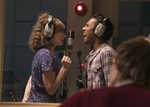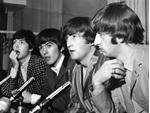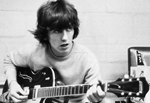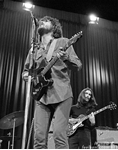- Register
- Log in to Tune-In
- Wishlist (0)
-
Shopping cart
(0)
You have no items in your shopping cart.
Beatles News

Everyone’s favorite knight of the realm will observe turning 79 on July 7 by inviting the world to come together in a moment of peace, love and unity. Starr himself will be in front of the famous Capitol Records Tower in Los Angeles, but don’t feel like you have to make the trip. All he asks is for everyone — everywhere — to think, say, or post “#PeaceandLove” at noon their local time, thus creating a wave of positivity that will travel across the globe.
The annual celebration began in 2008, when an interviewer casually asked Starr what he wanted for his birthday. The answer, of course, was “Peace and Love.” Since then, the idea has flourished into an international event, earning sponsors including Starbucks, Life Is Good, SiriusXM and The David Lynch Foundation, an organization that teaches meditation to at-risk individuals.
Source: Jordan Runtagh/people.com
details

It’s been over 55 years since The Beatles first came crashing into America and nearly half-a-century since the band split up. Yet in all that time, no one has come close to topping or even matching the band’s success.
Sure, you’ll hear about the occasional Beatles milestone that today’s recording artist might surpass. When Drake logged more top-10 Billboard hits than the Fab Four, that generated headlines for a few days. However, Drake hasn’t even reached double digits when it comes to No. 1 hits.
After all, if you’re talking about the big milestones in the music business, you have to start with chart-toppers. On that front, The Beatles continue to rule the industry all-time with 20 No. 1 singles (on the Billboard Hot 100) and 19 No. 1 albums (on the Billboard 200).
Looking at the field, there’s one contender who has a shot at the group’s Hot 100 milestone but little chance of anyone passing the Fab Four for the most No. 1 albums.
Source: cheatsheet.com
details
If you want to compare the work of John Lennon and Paul McCartney in The Beatles, you’ll find an almost even level of success. One or the other wrote and sang on the majority of songs released by the Fab Four from 1963-70. (Paul had a slight edge when it came to the No. 1 tracks.)
But their approach to writing and recording could hardly be more different. By the mid-’60s, John took a sharp turn toward the experimental and psychedelic while Paul continued recording his “silly love songs” and tracks John referred to as “granny music.”
They also went about their business in the studio very differently. While Paul could be methodical and obsessive — at times, to the annoyance of John and everyone else — he thought in very concrete terms about what he wanted.
Source: cheatsheet.com
details
Celine Dion paid tribute to Sir George Martin at her London concert on Friday (05.07.19).
The 51-year-old star kicked off the Barclaycard presents British Summer Time Festival in Hyde Park and used the gig to remember the English record producer – known as "the fifth Beatle" – who she worked with on her 'Let's Talk About Love' album.
She said: "Many years ago, I had the honour and the privilege of working with the late great Sir George Martin, your very own Sir George Martin and he produced 'The Reason' for me. I wanted to mention his name before I sing this song because meeting with him and working with him, singing for him was more than a privilege, it was a true honour and I wanted to say a few words about him. So thank you so much."
And the star spoke about her involvement with 2018's 'Deadpool 2', when she recorded 'Ashes' for the soundtrack, although she joked that she originally hoped to star in it and win a Best Actress Oscar.
Source: list.co.uk
details
Ringo Starr sees messages of peace and love everywhere, even in his food. While flipping through a copy of his new book of photos, Another Day in the Life (September 24, Genesis Publications), he finds a shot he took of two carrots, which he had posed to mimic the familiar two-fingered V sign for nonviolence and goodwill. “They’re very peaceful carrots,” he says with a smile.For Ringo, “peace and love” has gone way beyond a personal mantra to become a public mission. Starting 11 years ago July 7, his birthday, the former Beatle began holding the Peace & Love birthday celebrations, for which he appears somewhere around the world and asks everyone to pause at noon to say, or think, the P and L words. This year, he’ll do so in front of the classic building that houses the Beatles’ former label, Capitol Records, in Los Angeles, just a few miles from Ringo’s current home in Beverly Hills. (Follow these festivities on Ringo’s Facebook and Instagram accounts.)
Source: Jim Farber/Jim Farber

Imagine there's no Beatles… it's actually pretty hard, isn't it, given their huge influence on pop?
New movie Yesterday does just that, though, telling the story of one man who has an accident and wakes up in a kind of alternate reality where the Beatles never existed, and only he can remember their songs.
The film has sparked new interest in the Beatles' colossal back catalogue, which takes in 38 Top 40 hits, of which 28 went Top 10, with 17 of those going to Number 1. Six of their songs are million-sellers, but when it comes to the digital age, how do those hits hold up? Look back at every Beatles hit single and album in their Official Chart archive
We looked at the Fab Four's most played songs on streaming services since streams began to be counted toward the chart in 2014 and, brilliantly, there's a HUGE shock at the top.
Source: Justin Myers/officialcharts.com
details
Director Danny Boyle is back after an underwhelming sequel to the seminal work of his career: Trainspotting. This time, he’s paired with veteran screenwriter Richard Curtis, best known for penning classic, cutesy romantic comedies like Four Weddings and a Funeral, Bridget Jones’s Diary, and Notting Hill. True to form, Curtis’s newest story is primarily a rom-com, but its fascinating premise is more akin to the fantastical what-ifs of About Time than the traditional intimacies of Love Actually. Curtis poses the pop culture-busting question: what if we never had The Beatles?
Jack Malik (Himesh Patel) is a singer/songwriter in Lowestoft, a small town in Suffolk, England. Plainly put, he’s going nowhere. He and his best friend/manager, Ellie Appleton (Lily James), tour around the county playing empty bars, vacant inns, and unknown and unattended tent stages at otherwise prominent festivals. His lack of success means he’s always on the brink of quitting, but no matter how underwhelming his original “Summer Song” really is, Ellie won’t let him details

The Rolling Stones’ Rock and Roll Circus is one of rock’s most memorable concert films, uniting some of the biggest names in rock history, with Mick Jagger fronting The Rolling Stones and being joined by The Who, Eric Clapton, and The Beatles icon John Lennon. Lennon agreed to perform at the show, but then rejected the offer when he saw boxing kangaroos. He sent Yoko Ono to demand the kangaroos be removed.
Lennon reconsidered after his request was met, and the kangaroos were no longer part of the show. The Rock and Roll Circus was the first time Lennon spread his wings without his Beatles bandmates, and was a hint of what was to come for him during his solo career in the 70’s after The Beatles break up. This Rock and Roll Circus performance was an odd and unique show, with a carnival vibe and crazy outfits. Jagger’s then girlfriend Marianne Faithfull is also featured as a performer in the film. Sadly John Lennon is no longer with us, but The Rolling Stones are on tour, and in an interview promoting a show, Keith Richards revealed the surprising Stones classic that he thinks is terrible.
Source: Brett Buchanan/alternativenation.net

It is extremely well reported that Andy Warhol became close friends with John Lennon throughout the 1970s, the pair becoming inseparable during their time in and around New York City.
The friendship of the blossomed after the introduction of Yoko Ono, the Japanese-American multimedia artist who rubbed shoulders with the likes of Warhol, Dan Richter, Peggy Guggenheim and other influential artists of the time.
John Lennon once described his wife as “the world’s most famous unknown artist: everybody knows her name, but nobody knows what she does,” which of course, acts as counter balance to her close friend Andy Warhol whose work became internationally renowned in a number of different fields.
Source: Far Out StaffJ/faroutmagazine.co.uk
details
Sir Paul McCartney bought his farm in Kintyre before he met Linda but it was her love of its "wildness and freedom" that created so many happy memories.
The former Beatle says the west of Scotland peninsula was one of their favourite places in the world and photographs from their time on High Park Farm form part of a new retrospective of Linda's work, being shown at Glasgow's Kelvingrove art gallery.
The pictures of rural Scottish life sit alongside photos of music legends such as Jimi Hendrix and Aretha Franklin which Linda took before the couple settled into their newfound home.
Sir Paul, now 77, told BBC Radio Scotland's Ricky Ross Meets programme his late wife was a trailblazing photographer before the pair got together and raised a family.
Source: Steven Brocklehurst BBC Scotland News
details
Popular music changed forever on March 22, 1963 when Please Please Me, the debut album from the Liverpool quartet called the Beatles was released. The 14 song session included the #1 title single, one of seven originals penned by the writing team of John Lennon and Paul McCartney
The British Invasion had begun. In a way, it never ended.
Sir Paul McCartney plays B.C. Place this week and the legacy of his former band — as well as his solo career — lives on well past most of his original musical peers. What it is that makes the man and his music matter more than most is the subject of countless books, papers and bottomless barroom banter. How four teenagers from the Northwest of England turned rock ‘n’ roll on its head is now contemporary cultural history played out in song.
Source: Allen McInnis / Montreal Gazette
details
“Yesterday,” directed by Danny Boyle, brings one of the most irresistible musical forces to film: The Beatles.
No, The Beatles aren’t actually in the movie, but the band's music is heavily incorporated. The plot revolves around a worldwide power outage causing the entire world to forget The Beatles
Only Jack Malik, played by Himesh Patel, remembers The Beatles. Malik, an unsuccessful singer-songwriter, takes many of The Beatles’ songs as his own and becomes a huge star.
Played wonderfully by Patel, Malik comes across as a loveable friend with the best of intentions at heart.
Another fabulous casting decision was Kate McKinnon as Malik’s new manager, Debra Hammer. McKinnon’s straightforward, insensitive jokes lend her usual "Saturday Night Live" charm to the film.
Source: Olivia Elston/idsnews.com
details
If you’re like most fans of The Beatles, you probably aren’t that interested in the technical details of the work in the studio. However, if you read anything at all about it, the more you realize how many innovations the Fab Four and their label’s studio wizards pulled off over the years.
A great example came on the Sgt Pepper’s epic “A Day in the Life.” For the end of the song, John Lennon asked his producer and engineers for ” a sound building up from nothing to the end of the world.” So they hired and orchestra and got as close as they could.
While that track might be the peak of the Beatles’ experimental phase, it didn’t come out of nowhere. Revolver, which the band recorded and released a year earlier (1966), showcased the Fab Four building toward those highs. By the time it was released, they’d quit touring for good.
Source: cheatsheet.com
details
Yesterday, the new film from screenwriter Richard Curtis (Love Actually) and director Danny Boyle (Slumdog Millionaire), offers up a unique premise. The film takes place in a world where The Beatles’ music suddenly ceases to exist. (This happens following a cosmic event of some sort.)
From that point on, no one knows the John Lennon epic “A Day in the Life,” the George Harrison ballad “Something,” or the Paul McCartney tune from which the movie takes its name. Only a young British singer-songwriter of Indian descent is aware of the Fab Four catalog.
Obviously, that’s a formula for success for the struggling musician, and it’s also an interesting premise for a film. On the movie’s opening weekend, Yesterday surprised in theaters with a $17 million take.
Source: cheatsheet.com
details
Fifty years back, on January 30, 1969, George Harrison stepped on to the roof of his group's Apple headquarters in London and plugged in a Fender Telecaster. Famously, it would be The Beatles' last ever public performance. Not quite so famously, his guitar was an unusual model, a new Rosewood Telecaster that he'd recently received from Fender.
In fact, it was the fourth Fender guitar that The Beatles had acquired. During their early years, the group hadn't owned any Fenders, although George had written to a friend in 1960 that the guitar he "might manage" was a Strat. Instead, he decided to indulge his passion for Gretsch guitars—the brand used by one of his six-string heroes, Chet Atkins—and bought a secondhand Duo Jet, and, later, a couple of Country Gents and a Tennessean. The Beatles - "Don't Let Me Down," live on the Apple rooftop.
But George didn't have to wait too long to get his Fender: in 1965, he and John Lennon each acquired a secondhand Strat for studio use. Two years later, Paul McCartney bought an Esquire. Paul was becoming increasingly confident with six rather than four strings. After all, he'd started in the group as a guitarist. He soon put the new Esquire to good use, for exa details
